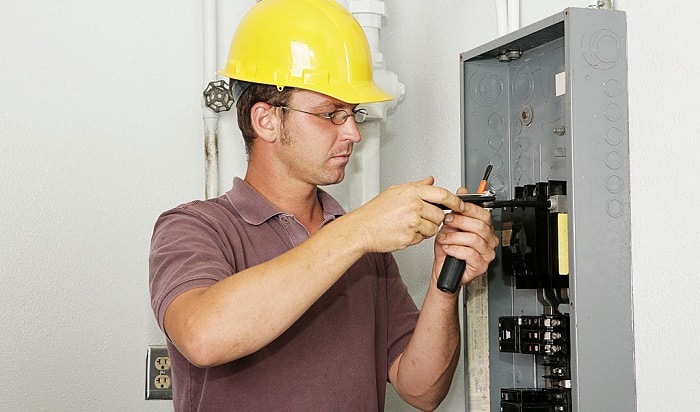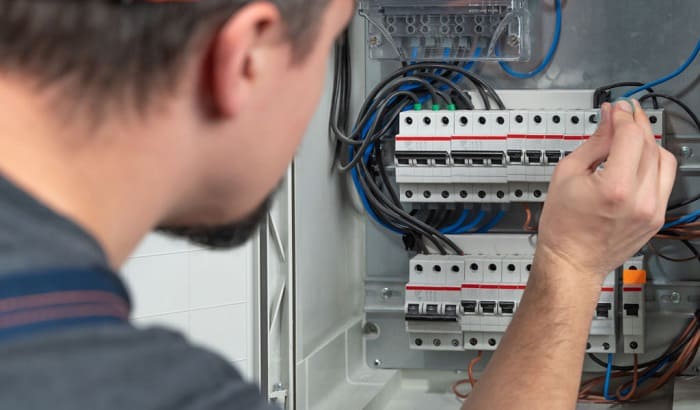If you want to know how to change a 30 amp breaker to a 50 amp breaker, you’ll have to know the specifics involved. You’re probably already aware of the risk of fire if you overload your circuits. Wiring a circuit breaker is never permitted for DIY projects because of the dangers involved.
This guide will take you through all the necessary steps like figuring out the correct wire gauge and doing the actual upgrading of the breaker. On the whole, it’s really all about paying attention to the right wiring.
Table of Contents
Tools Required for This Job
These are what electricians typically use to do this:
- Insulated screwdriver
- Correct wire gauge for 50-amp breaker (8-gauge)
- Rubber or insulated gloves
- 50-amp breaker
- Flashlight
- Voltage tester
Figuring Out the Right Wire Gauge
Before starting, it’s important to know the correct wire to use. Since you’re making a significant jump from 30 amps to 50 amps, the wire sizes will definitely have to be changed. This is an advanced job best left to a professional electrician unless you decide to change only the breaker, which is never recommended as you’ll end up pairing it with the wrong wire.
To safely convert 30 amp to 50 amp breakers, the circuits have to be able to support the higher load. To know the correct wire gauge, you can’t depart from local codes. A 30-amp breaker requires a 10-gauge wire, while a 50-amp one will need an 8-gauge one.
This doesn’t take into consideration how long the wire run will be. Also, this doesn’t take into account instances when wires are covered by sheetrock. You may need demolishing tools like a hammer to expose the entire wiring run that needs to be replaced.
However, if it happens that you already have the correct wiring in place (i.e. an 8-gauge one), then you can proceed to the next step of replacing your old 30-amp breaker by following these steps:
How to Upgrade from a 30-Amp Breaker to a 50-Amp One
1. Open the breaker panel.
Put on your rubber gloves then use the screwdriver to unscrew all the screws that set the cover in place. Handle each screw carefully and be sure to support the panel’s cover so it won’t end up dropping once you’ve taken out the last screw.
2. Kill the power to the main breaker then take off the 30-amp breaker.
You can’t skip turning off power to the main breaker to ensure safety. You confirm if there’s still power by using the voltage tester. Once that’s done, find and confirm the circuit breaker you want to replace by using the flashlight. Unscrew all the screws setting them in place then carefully pull their wire. Once it’s loose you can position it on the panel’s side first.
Don’t compromise on your safety! I’d even recommend you check all the hot wires first before removing anything. There might still be voltage running to the main breaker even after you’ve switched off the power so always exercise caution!
3. Once you’ve removed the former breaker, set the 50-amp breaker in place.
Assuming you already have the right-sized wires in place, putting in the new breaker shouldn’t be a hassle. The video above shows a good demonstration of it already. In most cases, I only have to insert it sideways then apply a bit of pressure to make sure it goes in right.
4. Restart the power then replace the cover.
With the wiring and new breaker installed properly, you can now turn on the power. Is the breaker showing signs of trouble? You may want to test it with a voltage meter to figure out why it’s tripping. Please watch this video to learn a neat way to do this.
If everything’s working topnotch, as it should, you can now put the cover back in place.
What If You Need to Rewire Your Panel First
Completely rewiring an electrical panel is not a suitable DIY project. If you have to do this first before being able to change your previous breaker, then you’ll have to call an electrician to perform it for you. This is the only way for most people because it will require a special permit from your local electric company to kill the power to the feeder wires.
Incidentally, Spruce has already laid out a good reference article of what this usually looks like. Go to their website if you want to learn how it usually goes for most home projects.
On the whole, expect this to be a major endeavor in and of itself, as you’ll have to invest time and money in getting it done properly. As I mentioned before, you may even need to demolish a couple of things to access the entire wiring system.
That being said, that’s precisely why some experts recommend upgrading the entire panel board or installing a new one to optimally meet the electrical demands of your appliances that require a 50-amp breaker.
Conclusion
Have you found the information I shared here useful? As you can see, changing from a 30-amp breaker to a 50-amp circuit breaker should never be handled by a DIYer if the correct wiring isn’t in place yet. There are simply too many technicalities involved.
If you already have the lines, then I can vouch for the steps on how to change a 30 amp breaker to a 50 amp breaker above. I’d be glad to know any feedback or thoughts you may have regarding this topic, so please feel free to share them below!

I am Andrew Wright. With 8 years of experience designing, installing, and maintaining electrical power systems. I love my job, and I have always wanted to offer others the necessary help so they can take care of their houses.



